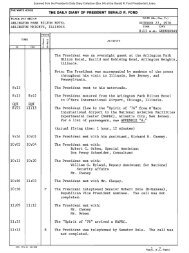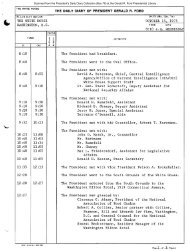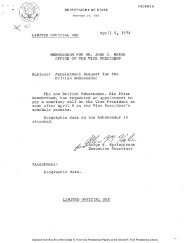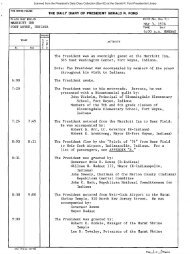October 31, 1975 - Gerald R. Ford Presidential Library and Museum
October 31, 1975 - Gerald R. Ford Presidential Library and Museum
October 31, 1975 - Gerald R. Ford Presidential Library and Museum
Create successful ePaper yourself
Turn your PDF publications into a flip-book with our unique Google optimized e-Paper software.
The Huntington Beach oil field is located in Orange CountYt California,<br />
about 15 miles southeast of the city of Long Beach. The field is in<br />
the Los Angeles Basin situated both onshore <strong>and</strong> offshore.<br />
The producing s<strong>and</strong>s are in an alternating s<strong>and</strong>-shale sequence principally<br />
in the Repetto Series of the Lower Pliocene age <strong>and</strong> the Puente<br />
Series of the Upper Miocene age. Drilling depths range from 1,800<br />
feet to 5,500 feet (true vertical depths).<br />
The field con5ists of three distinct structural features. One is a<br />
simple anticline offshore, to the southwest, that is relatively<br />
unfaulted. The second is a complexly faulted central area which<br />
lies between the Ocean Avenue <strong>and</strong> the Inglewood fault systems. The<br />
final is a generally northeasterly dipping flank to the northeast of the<br />
Inglewood fault system. The accumulations are controlled by structure t<br />
by faulting, by interbedded shales, by the overlying Pico shale t<br />
<strong>and</strong> by bottom water. The field has 5,300 productive acres (8 square<br />
miles) of which some 2,300 acres lie offshore in State controlled<br />
waters.<br />
A number of producing mechanisms are active in the various s<strong>and</strong> groups<br />
<strong>and</strong> in the different producing areas. The crude appeared to be<br />
initially undersaturated. The primary recovery mechanism was principally<br />
fluid expansion <strong>and</strong> dissolved gas drive. An active water<br />
drive is present in at least one of the medium sized reservoirs.<br />
Most of the major reservoir units are either under active water<br />
flood or they have future water flood secondary reserves indicated<br />
on the Summary Table. One of the shallow reservoirs, producing<br />
heavy crude oil, has responded well to cyclic steam injection <strong>and</strong><br />
steam drive operations are under study. However, the consultant<br />
firm has not yet included steam drive secondary reserves in the<br />
indicated category because of failure of the two steam drive projects<br />
which have been carried out thus far. Water flooding is not considered<br />
possible for some of the reservoir units in the highly faulted areas.<br />
The consultant firm has estimated proved reserves on a reservoir<br />
basis for the fourteen most important reservoirs in the various field<br />
areas. The future production decline rates are estimated to be quite<br />
severe because of the generally advanced nature of most of the active<br />
water floods <strong>and</strong> the likelihood that additional water flood activities<br />
<strong>and</strong> offshore development cannot be carried out in the forecast time<br />
span. In the offshore area there are proved reserves which cannot<br />
be reached by slant wells from either onshore drilling sites or<br />
existing platforms. The consultant firm does not contemplate that<br />
the existing environmentalist climate will permit the exploitation<br />
of these reserves in the next ten years. Approvals Qr permissions<br />
from 13 different agenices would be required.<br />
96
















